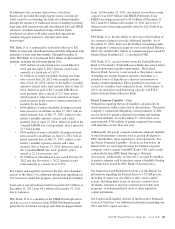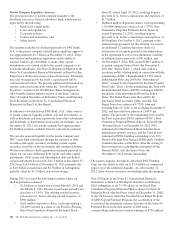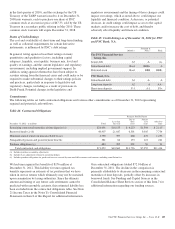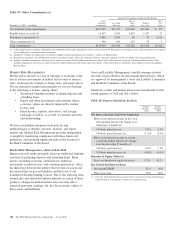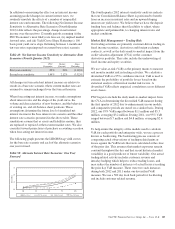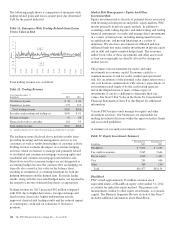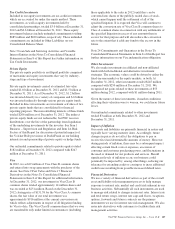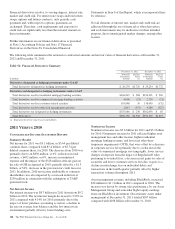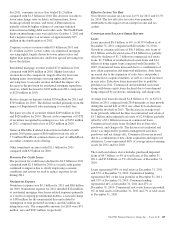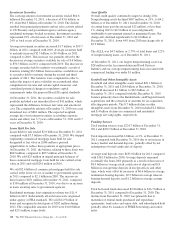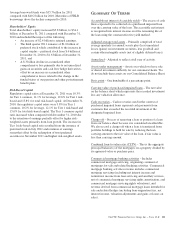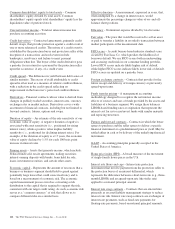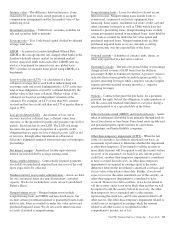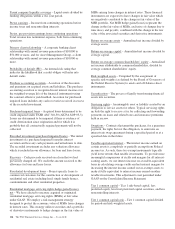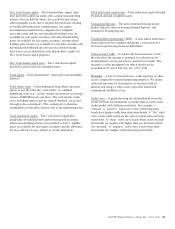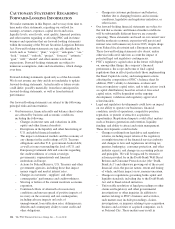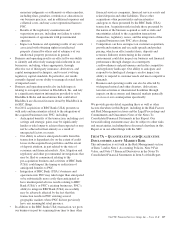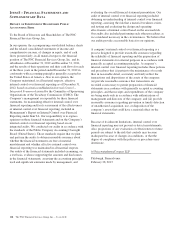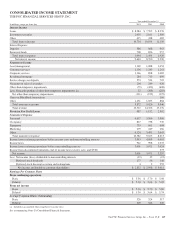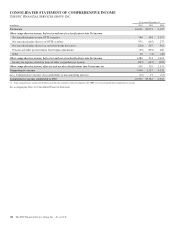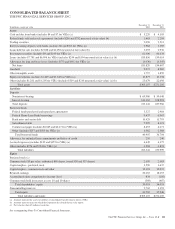PNC Bank 2012 Annual Report Download - page 130
Download and view the complete annual report
Please find page 130 of the 2012 PNC Bank annual report below. You can navigate through the pages in the report by either clicking on the pages listed below, or by using the keyword search tool below to find specific information within the annual report.
Average borrowed funds were $35.7 billion for 2011
compared with $40.2 billion for 2010. Maturities of FHLB
borrowings drove the decline compared to 2010.
Shareholders’ Equity
Total shareholders’ equity increased $3.8 billion, to $34.1
billion, at December 31, 2011 compared with December 31,
2010 and included the impact of the following:
• An increase of $2.4 billion to retained earnings,
• The third quarter 2011 issuance of $1.0 billion of
preferred stock which contributed to the increase in
capital surplus – preferred stock from $.6 billion at
December 31, 2010 to $1.6 billion at December 31,
2011, and
• A $.3 billion decline in accumulated other
comprehensive loss primarily due to net unrealized
gains on securities and cash flow hedge derivatives,
offset by an increase in accumulated other
comprehensive losses related to the change in the
funded status of our pension and other postretirement
benefit plans.
Risk-Based Capital
Regulatory capital ratios at December 31, 2011 were 10.3%
for Tier 1 common, 11.1% for leverage, 12.6% for Tier 1 risk-
based and 15.8% for total risk-based capital. At December 31,
2010, the regulatory capital ratios were 9.8% for Tier 1
common, 10.2% for leverage, 12.1% for Tier 1 risk-based and
15.6% for total risk-based capital. The Tier 1 common capital
ratio increased when compared with December 31, 2010 due
to the retention of earnings partially offset by higher risk-
weighted assets primarily from loan growth. The increase in
Tier 1 risk-based capital ratio resulted from the issuance of
preferred stock in July 2011 and retention of earnings
somewhat offset by the redemption of trust preferred
securities in November 2011 and higher risk-weighted assets.
G
LOSSARY
O
F
T
ERMS
Accretable net interest (Accretable yield) – The excess of cash
flows expected to be collected on a purchased impaired loan
over the carrying value of the loan. The accretable net interest
is recognized into interest income over the remaining life of
the loan using the constant effective yield method.
Adjusted average total assets – Primarily comprised of total
average quarterly (or annual) assets plus (less) unrealized
losses (gains) on investment securities, less goodwill and
certain other intangible assets (net of eligible deferred taxes).
Annualized – Adjusted to reflect a full year of activity.
Assets under management – Assets over which we have sole
or shared investment authority for our customers/clients. We
do not include these assets on our Consolidated Balance Sheet.
Basis point – One hundredth of a percentage point.
Carrying value of purchased impaired loans – The net value
on the balance sheet which represents the recorded investment
less any valuation allowance.
Cash recoveries – Cash recoveries used in the context of
purchased impaired loans represent cash payments from
customers that exceeded the recorded investment of the
designated impaired loan.
Charge-off – Process of removing a loan or portion of a loan
from our balance sheet because it is considered uncollectible.
We also record a charge-off when a loan is transferred from
portfolio holdings to held for sale by reducing the loan
carrying amount to the fair value of the loan, if fair value is
less than carrying amount.
Combined loan-to-value ratio (CLTV) – This is the aggregate
principal balance(s) of the mortgages on a property divided by
its appraised value or purchase price.
Commercial mortgage banking activities – Includes
commercial mortgage servicing, originating commercial
mortgages for sale and related hedging activities. Commercial
mortgage banking activities revenue includes commercial
mortgage servicing (including net interest income and
noninterest income from loan servicing and ancillary services,
net of commercial mortgage servicing rights amortization, and
commercial mortgage servicing rights valuations), and
revenue derived from commercial mortgage loans intended for
sale and related hedges (including loan origination fees, net
interest income, valuation adjustments and gains or losses on
sales).
The PNC Financial Services Group, Inc. – Form 10-K 111


